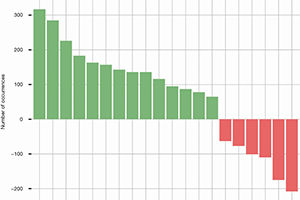Computational sentiment analysis of an online left ventricular assist device support forum: positivity predominates
Abstract
Background: The impact of left ventricular assist device (LVAD) complications on the individual patient, overall sentiment, and its effect on referral patterns, is not fully understood. We sought to better understand patient attitudes towards LVAD therapy using a computational sentiment analysis approach.
Methods: Posts, comments, and titles were parsed from MyLVAD.com’s HTML as a text file using custom Python scripts (version 3.6). Individual word frequency was computed with word classification as ‘positive’, ‘negative’, or ‘neutral’. Data transformation and cleaning, sentiment determination, and analysis was performed with a binary dictionary package using R software (version 3.6).
Results: Sixty-six thousand eight hundred and twenty-one unique words were noted, including 4,623 (6.9%) with positive sentiment and 3,248 (4.8%) with negative sentiment. Net sentiment ratio [(number of positive words – number of negative words)/(number of total words)] was 2.1%. Positive sentiment dominated the 20 most commonly used words. Odds ratio of non-neutral words [(number of positive words/number of negative words)] was 1.42, indicating a less obvious disparity in sentiment when expanding analysis beyond the top 20 words. Word cloud analysis of positive and negative sentiments was performed, indicating common use of “infection” (208 mentions) compared to other complications such as “stroke” (29 mentions), “bleeding” (30 mentions), and “thrombosis” or “clot” (32 mentions).
Conclusions: Positive sentiment dominates the most frequently used words, yet this disparity decreases when considering the totality of words. “Infection” is mentioned a disproportionate number of times compared to other LVAD complications. Further research is required to address analysis limitations, including selection bias.
Cover






